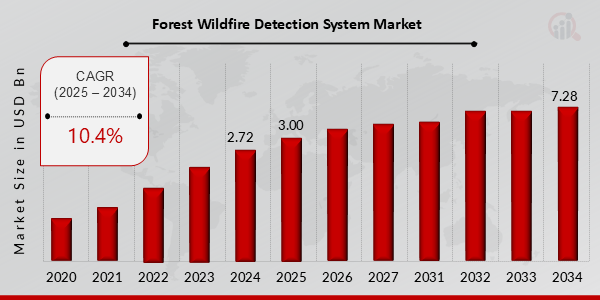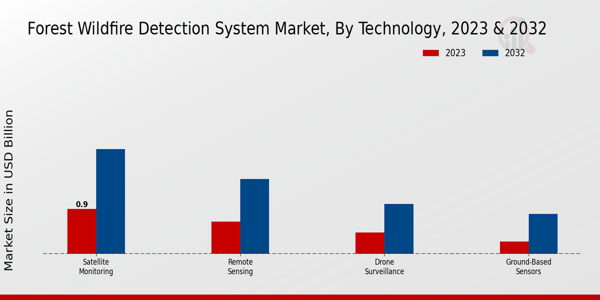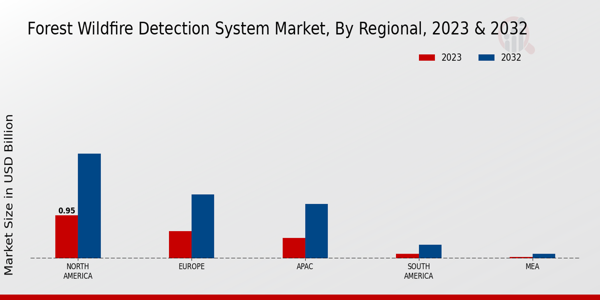Global Forest Wildfire Detection System Market Overview:
Forest Wildfire Detection System Market Size was estimated at 2.72 (USD Billion) in 2024. The Forest Wildfire Detection System Market Industry is expected to grow from 3.00 (USD Billion) in 2025 to 7.28 (USD Billion) till 2034, exhibiting a compound annual growth rate (CAGR) of 10.4% during the forecast period (2025 - 2034).
Key Forest Wildfire Detection System Market Trends Highlighted
The Forest Wildfire Detection System Market is experiencing a significant shift driven by several key market drivers. The increasing frequency and intensity of wildfires due to climate change have heightened the demand for efficient detection systems. Governments and organizations are now prioritizing measures to prevent wildfires, leading to enhanced investment in advanced technologies. Moreover, the growing awareness of environmental conservation and the economic impact of wildfires further fuels the need for reliable detection systems. This scenario presents a vital opportunity for businesses to innovate and offer solutions tailored to address the urgency of wildfire monitoring and management.
Recent trends indicate a rise in the adoption of satellite-based technologies and drones for forest monitoring. These advancements offer real-time data collection capabilities, significantly improving the accuracy of early wildfire detection. The integration of artificial intelligence and machine learning into detection systems is also becoming increasingly popular, allowing for faster analysis and response times. As the technology evolves, systems are becoming more accessible and user-friendly, encouraging broader adoption among various stakeholders, including governmental bodies and private organizations. As market participants look to capture emerging opportunities, partnerships and collaborations between technology firms and government agencies are becoming essential.
There is also a push for the development of more integrated systems that combine data from multiple sources, allowing for a holistic view of wildfire risks. Sustainability practices are influencing new product designs and promoting the use of eco-friendly materials and methods. Overall, the Forest Wildfire Detection System Market is on an upward trajectory, shaped by technological advancements and a collective effort to mitigate the impact of wildfires on ecosystems and communities.

Source: Primary Research, Secondary Research, MRFR Database and Analyst Review
Forest Wildfire Detection System Market Drivers
Rising Incidence of Forest Wildfires
The increasing frequency and intensity of forest wildfires globally has emerged as a predominant driver for the Forest Wildfire Detection System Market Industry. Various factors contribute to the surge in wildfires, including climate change, which has resulted in prolonged dry conditions and increased temperatures across many regions. These environmental changes have led to a significant increase in forest areas susceptible to wildfires, necessitating advanced detection systems to monitor and manage these risks effectively.
The devastating impact of wildfires on ecosystems, air quality, and human settlements has raised awareness among governments and organizations about the need for improved wildfire detection and response strategies. Technology plays a critical role in these efforts, enabling quicker identification and action against potential wildfire threats. By leveraging advanced detection systems, authorities can optimize resource allocation, enhance emergency response times, and ultimately reduce the devastation caused by wildfires. This growing recognition of the need for sophisticated monitoring solutions is driving investments in the Forest Wildfire Detection System Market, further propelling the industry's growth and innovation.
Government Initiatives and Funding
Government initiatives aimed at combating forest fires have significantly bolstered the Forest Wildfire Detection System Market Industry. Various countries are increasingly allocating funds to develop and implement sophisticated wildfire detection technologies, alongside establishing regulations to ensure effective monitoring. These initiatives not only enhance public safety but also protect valuable natural resources from the destructive impact of wildfires.With the support of governmental organizations, there is a robust push for advanced technologies such as satellite monitoring, drones, and real-time analytics. Such investments are pivotal in fostering innovation and driving market growth, as they enable comprehensive wildfire management strategies.
Technological Advancements in Detection Systems
Technological advancements have paved the way for significant improvements in wildfire detection capabilities, making it a crucial driver for the Forest Wildfire Detection System Market Industry. Innovations such as artificial intelligence, machine learning and remote sensing technologies are increasingly integrated into detection systems, enhancing their accuracy and response times. These advanced technologies allow for more efficient monitoring of vast forest areas, enabling early detection and rapid response to potential fire outbreaks. As they are expected to improve the protection of endangered forests as well as the safety of nearby communities, these technological enhancements are likely to increase the demand for aerial machinery, thus leading to the expansion of the market.
Forest Wildfire Detection System Market Segment Insights:
Forest Wildfire Detection System Market Technology Insights
The Forest Wildfire Detection System Market is significantly shaped by advancements in technology, particularly with an expected value of 2.23 USD Billion in 2023, rising to 5.4 USD Billion by 2032. This reflects a robust growth trajectory fueled by increasing concerns over forest fires due to climate change and urban encroachment, driving the demand for efficient monitoring systems. Within this landscape, Satellite Monitoring holds a majority share with a valuation of 0.9 USD Billion in 2023, expected to reach 2.1 USD Billion in 2032. This technology is significant due to its wide-area coverage and capability to provide real-time data on wildfire events, thereby aiding in prompt response efforts.
Remote Sensing, valued at 0.65 USD Billion in 2023 and projected to attain 1.5 USD Billion by 2032, also plays a crucial role as it allows for the analysis of soil moisture and vegetation, which are key indicators of fire risk, making it essential for predictive analytics in forest fire management. Similarly, Drone Surveillance, holding a valuation of 0.43 USD Billion in 2023 and anticipated to grow to 1.0 USD Billion by 2032, is increasingly utilized for its ability to access remote areas and gather detailed imagery, enhancing situational awareness during wildfires.
Ground-based sensors, valued at 0.25 USD Billion in 2023 and expected to reach 0.8 USD Billion by 2032, round out the technological spectrum, offering localized monitoring and early detection capabilities that are vital in forested environments. The diversity among these technologies not only showcases their individual contributions to the Forest Wildfire Detection System Market but also highlights the collective effort in bolstering forest fire prevention and control mechanisms essential for protecting vital ecosystems and communities alike. The interplay of these technologies reflects the emerging market dynamics, where innovation is consistently driving the need for comprehensive wildfire detection solutions to address the escalating threats posed by forest fires globally.

Source: Primary Research, Secondary Research, MRFR Database and Analyst Review
Forest Wildfire Detection System Market Component Insights
This market, driven by rising wildfire incidents globally, is propelled by technological advancements in detection systems. The component segment prominently includes Hardware, Software and Services, each playing a critical role in enhancing fire detection and management. Hardware solutions provide the essential physical infrastructure for monitoring and detecting wildfires, while Software solutions enable data analysis and integration with other systems for effective response.
Services encompass maintenance and support, which are vital for ensuring the efficacy of the systems in place. The segmentation showcases the industry's response to evolving environmental challenges and the need for innovative solutions to mitigate wildfire risks. As highlighted in Forest Wildfire Detection System Market statistics, the increasing deployment of these systems reflects a significant commitment to protecting natural resources, enhancing public safety and optimizing resource management in forested areas. Moreover, the consistent growth of the market illustrates both a robust demand for advanced detection technology and the indispensable role that component integration plays in effective wildfire management.
Forest Wildfire Detection System Market Deployment Mode Insights
The On-Premise deployment method has been favored for its robust security and control over data, making it suitable for various organizations seeking dedicated systems for early wildfire detection and management. Meanwhile, the Cloud-Based deployment is gaining traction due to its scalability and cost-effectiveness, enabling easier access to advanced analytics and real-time data. This dual approach allows users to choose a system that best fits their operational needs and infrastructure. As the market evolves, the integration of cutting-edge technologies like IoT and AI into these deployment modes is enhancing detection capabilities, ultimately driving the Forest Wildfire Detection System Market growth. The rise in wildfire incidents due to climate change further fuels demand, making the careful consideration of deployment modes critical for effective wildfire management. The market statistics reaffirm the significance of these modes, highlighting their roles in addressing urgent environmental challenges.
Forest Wildfire Detection System Market End User Insights
Within this market, various end users play a crucial role, including Government Agencies, Forestry Departments, Environmental Organizations and Private Enterprises. Government Agencies dominate the landscape, as they are responsible for forest management and public safety, utilizing advanced detection systems to monitor and respond to wildfires effectively. Forestry Departments are pivotal for sustainable forestry practices, balancing the ecological needs and economic benefits, while Environmental Organizations focus on conservation efforts, often advocating for enhanced technology adoption.
Private Enterprises contribute significantly, offering specialized technology solutions that enhance detection and response mechanisms. The increasing frequency and intensity of wildfires globally necessitate effective early detection systems, which act as a significant driver of market growth. The emphasis on sustainable forest management and growing public awareness about environmental protection further enhance the importance of these end users, ensuring a collective effort against wildfires. The diverse needs and applications across these segments underscore the Forest Wildfire Detection System Market segmentation, making it vital for addressing contemporary environmental challenges.
Forest Wildfire Detection System Market Regional Insights
The Forest Wildfire Detection System Market revenue reflects notable growth across regional segments, with North America holding a majority share at 0.95 USD Billion in 2023, expected to rise to 2.3 USD Billion by 2032. This region's prominence stems from advanced technology adoption and a proactive approach to wildfire management. Europe follows with a market valuation of 0.6 USD Billion in 2023, growing to 1.4 USD Billion, driven by strong governmental policies and increasing public awareness of fire safety. The Asia-Pacific (APAC) region is also significant, represented by a valuation of 0.45 USD Billion in 2023, anticipated to reach 1.2 USD Billion, as nations ramp up their wildfire detection capabilities due to rising environmental concerns. South America, although smaller, shows potential with a current valuation of 0.1 USD Billion and is expected to grow to 0.3 USD Billion, mainly due to increased investment in environmental technology. Meanwhile, the Middle East and Africa (MEA) account for 0.03 USD Billion in 2023, set for a slight uptick to 0.1 USD Billion, as awareness of forest management grows but remains limited compared to other regions. Overall, the Forest Wildfire Detection System Market statistics showcase a dynamic landscape influenced by regional priorities and vulnerabilities to wildfires.

Source: Primary Research, Secondary Research, MRFR Database and Analyst Review
Forest Wildfire Detection System Market Key Players and Competitive Insights:
The Forest Wildfire Detection System Market has been witnessing significant competitive dynamics as concerns surrounding climate change and forest preservation become increasingly paramount globally. Various key players are actively developing advanced technology solutions aimed at early detection and management of forest fires. This necessity for timely intervention has spurred innovations in sensor technology, aerial surveillance and machine learning algorithms, fostering a landscape where companies are striving to offer more efficient and reliable detection tools. The increasing incidence of wildfires, coupled with the rising costs associated with forest management, has compelled governments and private organizations to invest heavily in robust detection systems. As a result, the market is becoming more competitive, with numerous entities working towards differentiation through technological advancements, partnerships, and customer engagement strategies.IBM stands out in the Forest Wildfire Detection System Market due to its established expertise in data analytics, artificial intelligence and cloud computing. The company leverages its strong research and development capabilities to ensure that its wildfire detection solutions are not only cutting-edge but also aligned with client needs in various environmental conditions. IBM’s presence in the market is bolstered by its collaboration with governmental agencies and non-profits focused on wildfire management. Their solutions often integrate advanced analytics with satellite imagery and IoT devices, significantly enhancing real-time monitoring and predictive capabilities. The company’s commitment to sustainability and corporate social responsibility reflects well on its brand, thereby increasing trust among potential customers who are seeking dependable wildfire detection solutions. This unique combination of technology, partnerships, and a strong reputation positions IBM favorably in the market landscape, making it a formidable competitor amid evolving industry demands. Fire Weather Index has carved out a niche within the Forest Wildfire Detection System Market by focusing on the meteorological aspects critical to wildfire occurrence and behavior. The company emphasizes the importance of real-time weather data analysis in determining fire risk levels, which is instrumental for effective forest fire management. By utilizing sophisticated modeling systems, the Fire Weather Index offers predictive analytics that helps in assessing potential fire hazards. Its influence is strengthened by collaborations with various environmental agencies and municipalities, spearheading initiatives aimed at reducing forest fire risks. The company’s unique propositions, such as localized weather forecasting and historical data analytics, empower forestry professionals and decision-makers to enact proactive measures. This scientific approach not only aids in the timely detection of potential wildfires but also enhances the overall management strategies employed by stakeholders in the forest management sector. The ability to provide actionable intelligence based on weather conditions ensures that the Fire Weather Index remains a relevant player in the global market, contributing significantly to advancing wildfire detection technologies.
Key Companies in the Forest Wildfire Detection System Market Include:
-
IBM
-
Fire Weather Index
-
GeoIQ
-
Foresight Weather
-
NASA
-
Planet Labs
-
Skyward Technologies
-
Wildfire Defense Systems
-
Aerospace Corporation
-
Microsoft
-
Raytheon Technologies
-
Woolpert
-
Siemens
-
Hexagon
-
Google
Forest Wildfire Detection System Market Industry Developments
The Forest Wildfire Detection System Market has seen significant developments recently with increased investments and technological advancements. Companies such as IBM, NASA, and Microsoft are enhancing their systems by integrating artificial intelligence and satellite data to improve detection accuracy and response times. The Fire Weather Index is gaining traction as strong predictive tools are becoming essential for fire management. Moreover, GeoIQ and Planet Labs are collaborating on innovative solutions, utilizing data fusion techniques to provide real-time analytics for wildfire detection. Recent mergers and acquisitions have also surfaced; for instance, Raytheon Technologies has shown interest in expanding its capabilities through potential partnerships.
Woolpert and Hexagon are actively engaging in synergistic activities to broaden their service offerings in fire detection technology. Concurrently, the market is experiencing a growth trend, with increasing demand for advanced detection systems linked to climate change and rising incidents of wildfires globally. This trend is pushing companies like Siemens and Wildfire Defense Systems to enhance their market valuations, ultimately leading to better solutions for wildfire prevention and response, making the market more competitive and innovative.
Forest Wildfire Detection System Market Segmentation Insights
Forest Wildfire Detection System Market Technology Outlook
-
Satellite Monitoring
-
Remote Sensing
-
Drone Surveillance
-
Ground-Based Sensors
Forest Wildfire Detection System Market Component Outlook
-
Hardware
-
Software
-
Services
Forest Wildfire Detection System Market Deployment Mode Outlook
Forest Wildfire Detection System Market End User Outlook
Forest Wildfire Detection System Market Regional Outlook
-
North America
-
Europe
-
South America
-
Asia Pacific
-
Middle East and Africa
| Report Attribute/Metric |
Details |
|
Market Size 2024
|
USD 2.73 Billion
|
|
Market Size 2025
|
USD 3.00 Billion
|
|
Market Size 2034
|
USD 7.28 Billion
|
|
Compound Annual Growth Rate (CAGR)
|
10.4% (2025-2034)
|
|
Base Year
|
2024
|
|
Market Forecast Period
|
2025-2034
|
|
Historical Data
|
2020-2023
|
| Market Forecast Units |
USD Billion |
| Key Companies Profiled |
IBM, Fire Weather Index, GeoIQ, Foresight Weather, NASA, Planet Labs, Skyward Technologies, Wildfire Defense Systems, Aerospace Corporation, Microsoft, Raytheon Technologies, Woolpert, Siemens, Hexagon, Google |
| Segments Covered |
Technology, Component, Deployment Mode, End User, Regional |
| Key Market Opportunities |
Integration of AI technologies, Expansion in developing regions, Adoption of IoT solutions, Government funding for fire prevention, Enhanced data analytics capabilities |
| Key Market Dynamics |
Technological advancements in detection, Increasing frequency of wildfires, Government regulations and initiatives, Growing awareness of climate change, Rising demand for automated solutions |
| Countries Covered |
North America, Europe, APAC, South America, MEA |
Frequently Asked Questions (FAQ) :
The Forest Wildfire Detection System Market is expected to be valued at 7.28 billion USD by the year 2034.
The expected CAGR for this market from 2025 to 2034 is 10.4%.
North America is projected to have the largest market size, valued at 2.3 billion USD in 2032.
Satellite Monitoring technology was valued at 0.9 billion USD in the year 2023.
The Drone Surveillance technology segment is expected to grow significantly, reaching 1.0 billion USD by 2032.
Key players in this market include IBM, Microsoft, Google and Raytheon Technologies, among others.
The Ground-Based Sensors technology segment is expected to reach 0.8 billion USD by 2032.
The Middle East and Africa (MEA) region has the lowest projected market size, estimated at 0.1 billion USD by 2032.
Remote Sensing technology was valued at 0.65 billion USD in the year 2023.
The APAC market is expected to be valued at 1.2 billion USD by 2032.

















